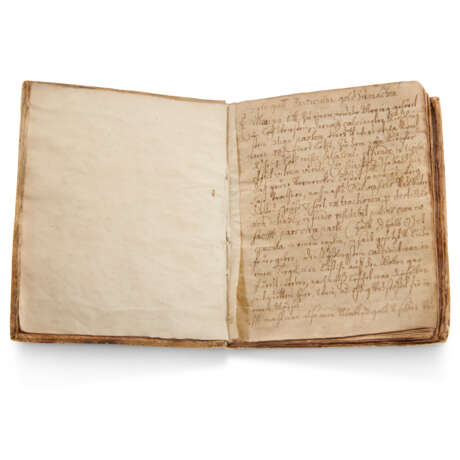ID 794522
Lot 45 | Anonymous German alchemist
Estimate value
£ 3 000 – 4 000
An alchemical notebook, in German and Latin, manuscript on paper [Germany, 17th century].
A working alchemist’s notebook containing detailed instructions on the alchemical processes of transmuting lesser substances into gold, with excerpts from contemporary alchemists such as Basilius Valentinus.
186 x 153mm. 158 leaves, apparently complete, contemporary foliation followed here, varying numbers of lines, text in a cursive German Schrift, in German and Latin, with alchemical symbols throughout and two diagrams on ff.2 and 156v (pages foxed and browned, text fading towards the end). Contemporary vellum over pasteboards, blind-tooled (scuffed and worn).
Content: A compilation of notes on the alchemical process, beginning with a way to make gold: ‘Ein gutt Particular gold zu machen’ (f.1), and including a recipe for Oil of the Philosophers (f.7), ‘Crocum [alchemical symbol for iron]’ – ferric oxide (f.9v), ‘Oleum sulphuris’ – or fuming sulphuric acid (f.10v), ‘Augmentum [alchemical symbol for gold]’ (f.18v), the process of coagulation of mercury (f.23), a recipe for Oil of Vitriol (f.33), a recipe for making bismuth (f.34), ‘Ein schön und treffliche Particular Tinctur ex [alchemical symbols for iron, copper and gold] aus Fratr. Basilii Valentini’ f.35, the transmutation of copper (f.38), the separation of gold from antimony (f.63), ‘Modus faciendi Cinabari’, in Latin (f.63v), a list of days and months on which the alchemical process should not be performed (ff.80-80v), a recipe for flowers of antimony (by roasting and condensing white fumes), ‘Weise Flores [alchemical symbol for antimony] zü machen (f.82v), a list of ingredients, with a mention of a Dr Hertoch at the bottom (f.158).
There are a few mentions in the text of near-contemporary alchemists, among whom ‘Sigismundo Fueger’ on f.25 – presumably this is the same Sigmund Fueger, Swiss professor of alchemy, whose mines Paracelsus worked at at an early age. The treatise on f.35 for a tincture from iron, copper and gold is drawn from Basilius Valentinus, a German alchemist initially thought to be a 15th-century Benedictine monk whose alchemical works first began circulating in the 17th century, but whose identity was in fact more probably that of the German author, alchemist and editor Johann Thölde (c.1565-1614). His most famous work was Triumphwagen des Ammonii, published in Leipzig in 1604.
Special notice
No VAT on hammer price or buyer's premium.
| Place of origin: | Western Europe, Germany, Europe |
|---|---|
| Auction house category: | Medieval & renaissance manuscripts, Medicine & science |
| Place of origin: | Western Europe, Germany, Europe |
|---|---|
| Auction house category: | Medieval & renaissance manuscripts, Medicine & science |
| Address of auction |
CHRISTIE'S 8 King Street, St. James's SW1Y 6QT London United Kingdom | |
|---|---|---|
| Preview |
| |
| Phone | +44 (0)20 7839 9060 | |
| Buyer Premium | see on Website | |
| Conditions of purchase | Conditions of purchase |



